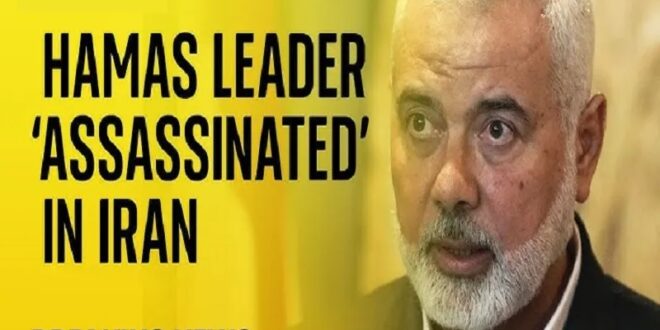Haniyeh’s assassination is a watershed event in the latest Israeli-Hamas War, which is now a regional Israeli-Iranian proxy war, since it greatly spikes the risk of everything spiraling into “mutually assured destruction”.
Hamas’ political leader Ismail Haniyeh was assassinated by Israel early Wednesday morning in the heart of the Iranian capital hours after attending President Masoud Pezeshkian’s inauguration. The details remain unclear, but it’s widely thought that he was killed by a precision drone strike at his residence. The world is watching to see whether Iran and/or its Resistance Axis allies will respond, what form it could take if so, and whether that would escalate tensions to a wider war. Here are five takeaways thus far:
- Israel’s Intelligence & Tactics Are Top-Notch
Israel somehow or another obtained accurate intelligence about Haniyeh’s location despite it being top-secret and was then able to successfully assassinate him. Whatever air defenses (including electronic warfare ones) that Iran had deployed in its capital as part of the security measures to protect its high-profile guests failed to thwart this attack. This is a major embarrassment for the Islamic Republic and prompts speculation about whether it was due to utter incompetence or was partially an inside job.
- Iran Is Caught In A Dilemma Over How To Respond
It’s unimaginable that Iran won’t respond to its Israeli enemy assassinating a high-profile allied guest in Tehran during the new president’s inauguration, but the dilemma is over the form that this response will take. Launching another drone and missile salvo against Israel like it did in the spring after the bombing of its consulate in Damascus is possible, though Israel could spin that as a failure if many of them are shot down like last time, the on-the-ground damage is minimal, and no high-profile targets are killed.
- Mutually Assured Destruction Hangs Heavy Over Everyone’s Head
The response that Iran resorts to will be determined by its leadership’s understanding of how far they can go without triggering the “mutually assured destruction” (MAD) scenario, which both Israel and the Resistance Axis fear and is why they’ve thus far restrained themselves from waging all-out war. A repeat of spring’s salvo could remain below that threshold, but Iran might also respond in a different way that’s interpreted by Israel as an escalation, thus prompting its own escalation that could then lead to MAD.
- A Choreographed Response Might Therefore Be The Most “Rational”…
Duma member Dmitry Belik, whose claim to fame was helping Sevastopol reunify with Russia when he briefly served as the region’s acting head in spring 2014, described spring’s salvo as a “beautiful theatrical production”. If there’s any truth to his innuendo that Iran choreographed its response with the US and/or Israel to Israel’s bombing of its consulate in Syria, then it might also do the same after Haniyeh’s assassination, which could help Iran “save face” while averting an escalation towards MAD.
- …But There’s No Guarantee That Iran’s Allies Will “Stand Down”
Hamas and Hezbollah are Iran’s allies but operate independently of it despite their close ties. There’s accordingly no guarantee that they’ll “stand down” and not respond in their own way if Iran sends another salvo to Israel regardless of whether or not it’s choreographed. After all, Hamas’ political chief was just killed, while one of Hezbollah’s top commanders was assassinated by Israel in Beirut the day prior. This makes the MAD risk even less manageable since those two might not share Iran’s calculations.
Haniyeh’s assassination is a watershed event in the latest Israeli-Hamas War, which is now a regional Israeli-Iranian proxy war, since it greatly spikes the risk of everything spiraling into MAD. Iran’s response will be crucial in determining whether or not that happens, but so too will Hamas and Hezbollah’s. They’ll either “stand down” as Iran responds regardless of whether or not it’s choreographed, participate in a joint response that remains below the MAD threshold, or decide to cross that red line on their own.
 Eurasia Press & News
Eurasia Press & News


